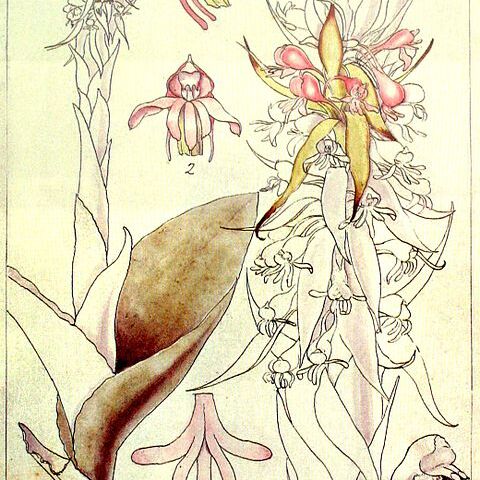Plants terrestrial, robust, 0.25-1.06 m high. Leaves 2 or 3, basal, partly erect, ovate-obtuse to oblong-lanceolate, 50-300 mm long. Inflorescence dense, 31-64-flowered; bracts fully deflexed. Flowers white to deep pink tinged darker on sepals and petals. Sepals 7-14 mm long, fused to petals and lip. Lip deeper than tall, apical flap 0.5 mm long, bent back with minute ridge; spur slender, 13-26 mm long. Flowering time Feb., Mar.
A herb. It is an orchid that grows in the soil. It grows 15-80 cm high. There are 6-10 leaves. The lowest ones form a sheath. The higher leaves are 24 cm long by 8 cm wide. The flowering stalks are 22 cm long. There are many flowers. The flowers are pink. The tubers are 2.5 cm long by 1 cm wide. They are oval.
Leaves 6–10, the lowest 1–3 sheath-like, the next 2 large and spreading, near the base of the stem but not appressed to the ground, 10–24 × 4.5–8 cm, ovate, glossy light green; the remainder spaced along the stem, much smaller and sheath-like.
Lip 8–10.5 mm long, 6.5–8.5 mm wide when spread out, very convex and hooded, the apex shortly reflexed, wide-mouthed and thin-textured.
Sepals and petals projecting forwards or slightly decurved, joined to each other and lip for about a third of their length.
Median sepal 10–15 × 1.5–2 mm, ligulate, obtuse; lateral sepals oblique, slightly shorter and 2–3 mm wide.
Column up to 8 mm high; stigma 1.5 × 2.5 mm; rostellum equally 3-lobed, the mid-lobe shortly bifid.
Terrestrial herb 15–80 cm high; tubers up to 2.5 × 1 cm, ± globose or ovoid, almost glabrous.
Bracts reflexed, up to 3 cm long at base of inflorescence, lanceolate, acute.
Inflorescence 7–22 × 2.5–4 cm, fairly densely 10-to many-flowered.
Spurs 12–20 mm long, slender, tapering, parallel to ovary.
Petals slightly shorter and broader than median sepal.
Ovary and pedicel 10 mm long, tinged with pink.
Flowers pale to deep pink or carmine-red.

